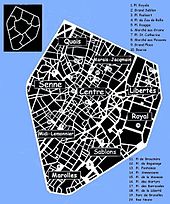
Brussels, officially the Brussels-Capital Region, is a region of Belgium comprising 19 municipalities, including the City of Brussels, which is the capital of Belgium. The Brussels-Capital Region is located in the central portion of the country and is a part of both the French Community of Belgium and the Flemish Community, but is separate from the Flemish Region and the Walloon Region.

The City of Brussels is the largest municipality and historical centre of the Brussels-Capital Region, as well as the capital of the Flemish Region and Belgium. The City of Brussels is also the administrative centre of the European Union, as it hosts a number of principal EU institutions in its European Quarter.

The Palace of Justice of Brussels or Law Courts of Brussels is a courthouse in Brussels, Belgium. It is the country's most important court building, seat of the judicial arrondissement of Brussels, as well as of several courts and tribunals, including the Court of Cassation, the Court of Assizes, the Court of Appeal of Brussels, the Tribunal of First Instance of Brussels, and the Bar Association of Brussels.
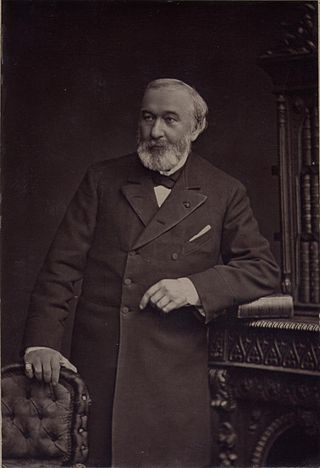
Joseph Poelaert was a Belgian architect. He was entrusted with important projects in Brussels, such as Saint Catherine's Church, the Church of Our Lady of Laeken, the Congress Column, the Royal Theatre of la Monnaie and above all, the Palace of Justice. He was also the great-uncle of the architect Henri Van Dievoet.
Between 23 and 29 September 2006, youths of mainly immigrant descent rioted in Brussels, causing the destruction of several shop windows and the burning of ten cars and part of a hospital. The immediate cause of the riots was anger at the unexplained death in custody of a local man of Moroccan origin, Fayçal Chaaban.
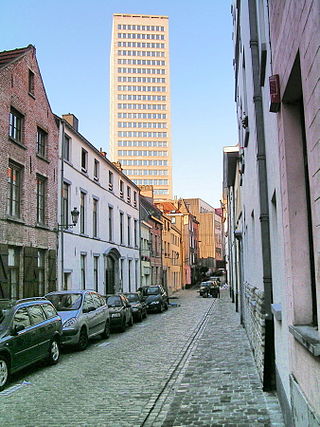
In urban planning, Brusselization or Brusselisation is "the indiscriminate and careless introduction of modern high-rise buildings into gentrified neighbourhoods" and has become a byword for "haphazard urban development and redevelopment."
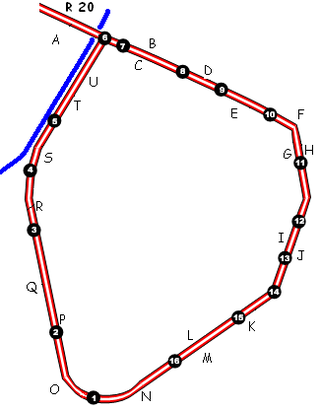
The Small Ring inner ring road, formally R20 and N0 is a series of roadways in central Brussels, Belgium, surrounding the historic city centre. The city centre is usually defined as the area within the Small Ring; this area is called the Pentagon due to its pentagonal shape. The pentagon forms the core of the City of Brussels municipality.

The covering of the Senne was the covering and later diverting of the main river of Brussels, Belgium, and the construction of public buildings and major boulevards in its place. Carried out between 1867 and 1871, it is one of the defining events in the history of Brussels.

The Marolles or Marollen is a popular historic neighbourhood of downtown Brussels, Belgium. It is situated between the Palace of Justice to its south-east, the Chapel Church to its north and the Halle Gate to its south. Its inhabitants are called Marolliens in French and Marollianen in Dutch.

The Fortifications of Brussels refers to the medieval city walls that surrounded Brussels, Belgium, built primarily to defend the city but also for administrative reasons. There were two stages of fortifications of Brussels; the first walls, built in the early 13th century, and the second walls, built in the late 14th century and later upgraded. Today, only a few sections of either remain.

The Halle Gate is a former medieval city gate and the last vestige of the second walls of Brussels, Belgium. Built between 1381 and 1383, it was heavily restored in the 19th century in its current neo-Gothic style by the architect Henri Beyaert. It is now a museum dedicated to the medieval City of Brussels, part of the Royal Museums of Art and History (RMAH).
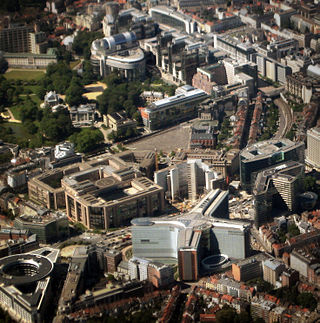
The Leopold Quarter is a quarter of Brussels, Belgium. Today, the term is sometimes confused with the European Quarter, as the area has come to be dominated by the institutions of the European Union (EU) and organisations dealing with them, although the two terms are not in fact the same, with the Leopold Quarter being a smaller more specific district of the municipalities of the City of Brussels, Etterbeek, Ixelles and Saint-Josse-ten-Noode.
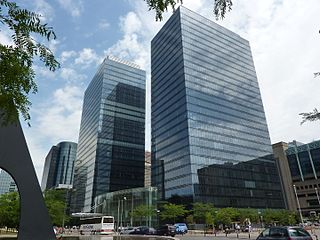
The Northern Quarter is the central business district of Brussels, Belgium. Like La Défense in Paris, the Docklands in London or the Zuidas in Amsterdam, the Northern Quarter consists of a concentrated collection of high-rise buildings where many Belgian and multinational companies have their headquarters.
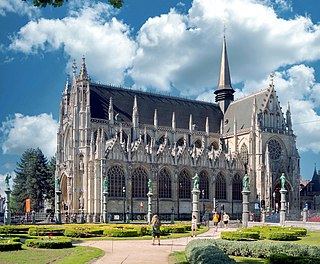
The Sablon or Zavel is a neighbourhood and hill in the historic upper town of Brussels, Belgium. At its heart are twin squares: the larger Grand Sablon or Grote Zavel square in the north-west and the smaller Petit Sablon or Kleine Zavel square and garden in the south-east, divided by the Church of Our Blessed Lady of the Sablon. This area is served by Brussels-Chapel railway station and Brussels Central Station, as well as the tram stop Petit Sablon/Kleine Zavel.

Brussels-Chapel railway station, officially Brussels-Chapel, is a railway station on the North–South connection in the City of Brussels, Belgium. Despite its city centre location and the busy passing railway line, few trains stop there nowadays.

The Place du Jeu de Balle or Vossenplein is a square located in the heart of the Marolles/Marollen district of the City of Brussels, Belgium. Since 1873, it has held a famous flea market, known as the Old Market.

The Royal Theatre Toone, often simply referred to as Toone, is a folkloric theatre of marionettes in central Brussels, Belgium, active since 1830, and the only traditional Brussels puppet theatre still in operation.

The Central Boulevards are a series of grand boulevards in central Brussels, Belgium. They were constructed following the covering of the river Senne (1867–1871), as part of the major urban works by the architect Léon Suys under the tenure of the city's then-mayor, Jules Anspach. They are from south to north and from west to east: the Boulevard Maurice Lemonnier/Maurice Lemonnierlaan, the Boulevard Anspach/Anspachlaan, the Boulevard Adolphe Max/Adolphe Maxlaan, and the Boulevard Émile Jacqmain/Émile Jacqmainlaan.

The Poelaert Elevators, in popular language Elevators of the Marolles is a public elevator in the Marolles/Marollen district of Brussels, Belgium. It connects the lower and upper town at the Square Breughel l'Ancien/Breughel de Oudeplein with the Place Poelaert/Poelaertplein, in the vicinity of the Palace of Justice. The elevator consists of two independent elevators, hence the plural elevators sometimes used for its name.

The Place Anneessens (French) or Anneessensplein (Dutch) is a square in Brussels, Belgium. It is named in honour of François Anneessens, dean of the Nation of St. Christopher, who was beheaded on the Grand-Place/Grote Markt during a period of uprisings within the Austrian Netherlands.
